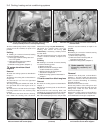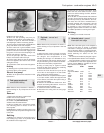
1 General information and
precautions
General information
The fuel system consists of a fuel tank
mounted under the rear of the car, a
mechanical fuel pump, and a single or twin
downdraught carburettor.
On manual transmission and early automatic
transmission models, the fuel pump is
operated by an eccentric on the camshaft, and
is mounted on the rear of the cylinder head. On
automatic transmission models manufactured
from November 1986, an electric fuel pump
submerged in the fuel tank is fitted instead of
the previous mechanical type. The two relays
which supply the pump are located on the side
of the heater. One relay incorporates a safety
feature, in that its primary windings are
short-circuited to earth via the engine oil
pressure switch. When the engine is stationary,
this relay will not operate the fuel pump, but as
soon as the engine is running it will supply
current to the pump. The other relay operates
in conjunction with the starter motor to operate
the fuel pump for starting.
A number of different Solex and Weber
carburettors may be encountered and their
type and engine applications are shown in the
Specifications. All carburettors are of the fixed
jet downdraught type with either manual or
automatic choke arrangements. XY8 engine
models utilise a twin carburettor configuration.
The air cleaner contains a disposable paper
filter element, and on certain models
incorporates a flap valve air temperature
control system; this allows cold air from the
outside of the car, and warm air from the
exhaust manifold, to enter the air cleaner in
the correct proportions.
Precautions
Warning: Petrol is extremely
flammable - great care must be
taken when working on any part
of the fuel system. Do not smoke
or allow any naked flames or uncovered
light bulbs near the work area. Note that
gas powered domestic appliances with pilot
flames, such as heaters, boilers and tumble
dryers, also present a fire hazard - bear this
in mind if you are working in an area where
such appliances are present. Always keep a
suitable fire extinguisher close to the work
area and familiarise yourself with its
operation before starting work. Wear eye
protection when working on fuel systems
and wash off any fuel spilt on bare skin
immediately with soap and water. Note that
fuel vapour is just as dangerous as liquid
fuel; a vessel that has just been emptied of
liquid fuel will still contain vapour and can
be potentially explosive. Petrol is a highly
dangerous and volatile liquid, and the
precautions necessary when handling it
cannot be overstressed.
Many of the operations described in this
Chapter involve the disconnection of fuel
lines, which may cause an amount of fuel
spillage. Before commencing work, refer to
the above Warning and the information in
“Safety first” at the beginning of this
manual.
When working with fuel system
components, pay particular attention to
cleanliness - dirt entering the fuel system
may cause blockages which will lead to
poor running.
2 Air cleaner assembly -
removal and refitting
1
Removal
All engines except TU series
1 Disconnect the inlet and warm air hoses.
2 Release the rubber straps from the
mounting brackets (see illustration).
3 Lift the air cleaner from the brackets then
disconnect the outlet hose and where fitted,
the crankcase ventilation hose.
4 If necessary, unbolt the mounting brackets
- noting the location of the diagnostic socket
and cable retaining brackets (see
illustrations).
TU series engines
5 Loosen the screw and release the air
cleaner ducting from the carburettor (see
illustration).
6 Disconnect the crankcase ventilation hose
(see illustrations) from the valve cover and
inlet manifold.
Fuel system - carburettor engines 4A•3
4A
2.6b . . . and inlet manifold2.6a Disconnect the crankcase ventilation
hose from the valve cover . . .
2.5 On TU series engines, slacken the air
cleaner and release the ducting from the
carburettor
2.4b . . . and cable retaining bracket2.4a Air cleaner mounting bracket bolt
(arrowed) . . .
2.2 On all engines except TU series,
release the air cleaner rubber straps from
the mounting brackets


















